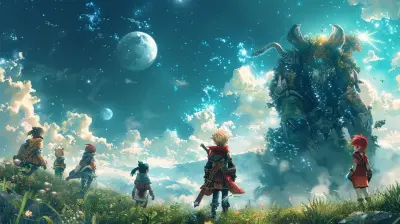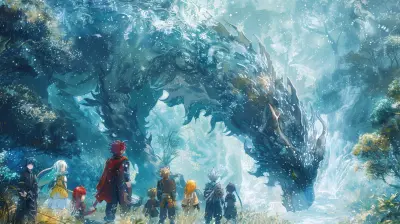20 March 2025
When it comes to building an immersive game world, factions are like the heartbeat of your narrative. They’re the groups, organizations, or alliances that give your world depth and meaning. Think of them as the spice rack in your kitchen—without them, everything ends up bland and predictable. Factions create conflict, spark intrigue, and give players something to rally behind or rebel against. But making factions that feel diverse and compelling? That’s an art form in itself.
If you’ve been scratching your head wondering how to create factions that add complexity to your game world, don’t worry—I’ve got you covered. Today, we’re diving into the nuts and bolts of creating diverse factions that suck players in and make your world unforgettable. So, grab your creative toolkit, and let’s get started!
Why Are Factions So Important in Game Design?
Before we dive into the "how," let’s talk about the "why." Why bother putting effort into factions in the first place? Well, factions are the glue that holds your game world together. They represent ideologies, cultures, and power struggles, and they give players a lens through which to interact with your narrative.Ever played a game and felt torn between joining the noble knights, the rebellious outlaws, or the shady merchants? That’s the power of well-crafted factions. They don’t just tell your story—they are your story.
Think about games like The Elder Scrolls V: Skyrim. The civil war between the Imperial Legion and the Stormcloaks doesn’t just add flavor to the world—it’s a central part of the experience. Players care because the factions are distinct, and their struggle feels real. That’s what you’re aiming for.
The Building Blocks of a Great Faction
So, what makes a faction compelling? It all boils down to diversity—not just in terms of appearances or names but in what they stand for, how they operate, and how they interact with the rest of the world. Let’s break it down.1. Core Ideology and Purpose
Every faction needs a reason to exist. What drives them? Are they fighting for freedom, power, survival, or something more abstract like knowledge? Their core ideology shapes everything they do and gives players a reason to care.For example, in Mass Effect, the Cerberus faction is driven by a belief in human supremacy. That ideology permeates their actions, making them intriguing (and infuriating) antagonists. Without a clear purpose, a faction feels hollow—like background noise instead of a real entity.
2. Distinct Culture and Aesthetic
Let’s be real—nobody wants to join a faction that feels cookie-cutter. Your factions should have their own unique style, from the way they dress to the symbols they use. Culture should bleed into every aspect of their identity, from their architecture to their speech patterns.Want a quick example? Look at World of Warcraft. The Horde and Alliance aren’t just two sides of a coin—they have completely different vibes. The Horde is gritty, primal, and tribal, while the Alliance is clean-cut, noble, and orderly. That contrast makes them memorable.
3. Conflict and Rivalries
Here’s the thing: factions need conflict to thrive. Without some kind of tension—whether internal or external—they come across as flat. Rivalries between factions keep the game world alive and give players meaningful choices.But don’t just settle for black-and-white morality. Instead of “good guys vs. bad guys,” aim for shades of gray. Think of Game of Thrones. The factions in Westeros are often neither entirely good nor evil—they’re complex, making the conflicts between them all the more engaging.
Steps to Create Diverse Factions in Your Game World
Now that we’ve covered the basics, let’s dive into the actionable stuff. How do you actually make these factions? Here are some step-by-step tips to help you craft diverse and impactful groups for your game world.Step 1: Start With the Setting
Factions don’t exist in a vacuum—they’re a product of your world. So, start by looking at your setting. Is it a high-fantasy kingdom, a futuristic dystopia, or a post-apocalyptic wasteland? The environment and tone of your game should influence your factions.For instance, in a cyberpunk world, you might have mega-corporations competing with underground hacker collectives. In a medieval fantasy, you could have noble houses vying for power while a secretive mage guild pulls the strings behind the scenes.
Ask yourself: What kind of world would give birth to these factions? What natural resources, geography, or political climates would shape their goals and identities?
Step 2: Define Goals and Motivations
Every faction needs a clear goal, but don’t stop there. Think about what motivates them. Are they driven by survival, greed, justice, revenge, or ambition? Motivations add layers to your factions and help players understand their actions.For example, let’s say you’re creating a faction of desert raiders. On the surface, their goal might be to pillage and plunder. But dig deeper—maybe their true motivation is survival because their homeland is facing a severe drought. That extra layer turns a generic group into something players can empathize with.
Step 3: Add Internal Divisions
Here’s a pro tip: even within the same faction, people don’t always agree. Introducing internal divisions or sub-factions can make your groups feel more realistic.Maybe within a kingdom’s army, there’s a faction of traditionalists who resist change and a faction of reformists pushing for progress. These internal conflicts keep things interesting and can lead to some juicy storylines.
Step 4: Create Memorable Leaders
Every faction needs a face—a leader who embodies their ideals. Think of them as the faction’s spokesperson. A great leader can make a faction unforgettable.Take Far Cry 4, for example. Pagan Min, the charismatic dictator, is one of the reasons the game’s factions stand out. His eccentric personality and dark humor make him impossible to ignore. Your faction leaders don’t have to be borderline insane, but they should be unique and memorable.
Step 5: Consider Player Interaction
At the end of the day, factions are there for your players to interact with. So, think about how they’ll engage with them. Will players join the faction, fight against it, or try to broker peace between rival groups?Give players meaningful choices that affect the way factions perceive them. Maybe siding with one faction earns you allies but makes another faction your enemy. These choices should have consequences, adding weight to every decision.
Mistakes to Avoid When Creating Factions
Even the best ideas can fall flat if you’re not careful. Here are some common pitfalls to watch out for when designing factions.1. Making Factions Too Similar
It’s easy to fall into the trap of creating factions that feel interchangeable. Avoid this by giving each group a distinct identity. If your factions don’t have clear differences, players won’t care about them.2. Ignoring Diversity
When we talk about diversity, we don’t just mean cultural or racial diversity (though that’s important too). Think about diversity in ideology, tactics, and values. Maybe one faction relies on brute strength while another uses stealth and sabotage. Variety keeps things fresh.3. Forgetting the World’s Influence
Your factions should feel like a natural extension of your world. If they feel out of place—like a tech-savvy hacker group in a medieval fantasy—it’ll break immersion. Make sure their existence makes sense in the context of your setting.Wrapping It Up
Crafting diverse factions is no easy task, but it’s one of the most rewarding aspects of game design. Factions breathe life into your world, giving players something to connect with, fight against, or ally with. They’re like the soul of your narrative, turning a static setting into a dynamic playground for storytelling.Remember, the key is to focus on their purpose, culture, and conflicts. Add layers of complexity, give them memorable leaders, and make sure they fit seamlessly into your world. And don’t forget—players want to feel like their choices matter. Let them engage with factions in meaningful ways, and you’ll have a recipe for an unforgettable game world.
So, what kind of factions are you dreaming up? A secretive assassin guild? A revolutionary underdog group? Or maybe a ruthless empire bent on domination? Whatever you create, make it something players can’t stop thinking about. That’s the ultimate goal.





Leah Smith
Great article! Emphasizing diverse factions adds depth and realism to game worlds. By exploring unique motivations and interactions, developers can create engaging narratives that enrich player experiences. Can't wait to see these ideas implemented in future games!
April 1, 2025 at 3:07 PM